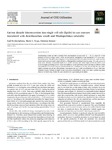Mostrar o rexistro simple do ítem
Carbon Dioxide Bioconversion Into Single Cell Oils (Lipids) In Two Reactors Inoculated With Acetobacterium Woodii and Rhodosporidium Toruloides
| dc.contributor.author | Robles-Iglesias, Raul | |
| dc.contributor.author | Veiga, María Carmen | |
| dc.contributor.author | Kennes, Christian | |
| dc.date.accessioned | 2021-11-09T12:30:45Z | |
| dc.date.available | 2021-11-09T12:30:45Z | |
| dc.date.issued | 2021-08-12 | |
| dc.identifier.citation | R. Robles-Iglesias, M.C. Veiga, C. Kennes, Carbon dioxide bioconversion into single cell oils (lipids) in two reactors inoculated with Acetobacterium woodii and Rhodosporidium toruloides, 52 (2021) 101668. https://doi.org/10.1016/j.jcou.2021.101668. | es_ES |
| dc.identifier.issn | 2212-9820 | |
| dc.identifier.uri | http://hdl.handle.net/2183/28815 | |
| dc.description | Financiado para publicación en acceso aberto: Universidade da Coruña/CISUG | es_ES |
| dc.description.abstract | [Abstract] Acetobacterium woodii was able to produce high concentrations of acetic acid, i.e., > 20 g/L, from CO2, in the presence of H2 as an energy source, which was favoured by maintaining a near-optimal pH of 7.8 in an automated bioreactor. This allows the mitigation of CO2 emissions for their conversion to acetic acid, which was then further used to produce lipids (single cell oils) by Rhodosporidium toruloides in the next assay. The yeast, grown on acetic acid, efficiently accumulated lipids in A. woodii’s medium, and further improved bioconversion would result in a highly promising process. Acetic acid inhibitory studies performed with R. toruloides, at different initial concentrations of the acid, using the fermented broth of A. woodii grown on CO2, showed that the yeast maintained a constant growth rate and substrate consumption rate up to acid concentrations of 15 g/L. Both rates remained roughly constant at higher initial acetic acid concentrations; except for a more extended lag phase observed in batch assays before the yeast entered in its exponential growth phase. | es_ES |
| dc.description.sponsorship | This research is part of a project funded through the Spanish Ministry of Science and Innovation and European FEDER funds (PID2020-117805RB-I00). RR thanks that Ministry for financial support of his doctoral contract (E-15-2019-0344365). The authors, belonging to the BIOENGIN group, thank Xunta de Galicia for financial support to Competitive Reference Research Groups (ED431C 2021/55). Funding for open access charge provided by Universidade da Coruña/CISUG | es_ES |
| dc.description.sponsorship | Xunta de Galicia; ED431C 2021/55 | es_ES |
| dc.language.iso | eng | es_ES |
| dc.publisher | Elsevier | es_ES |
| dc.relation | info:eu-repo/grantAgreement/AEI/Plan Estatal de Investigación Científica y Técnica y de Innovación 2017-2020/PID2020-117805RB-I00/ES/ | |
| dc.relation.uri | https://doi.org/10.1016/j.jcou.2021.101668 | es_ES |
| dc.rights | Atribución-NoComercial-SinDerivadas 4.0 Internacional | es_ES |
| dc.rights.uri | http://creativecommons.org/licenses/by-nc-nd/4.0/ | * |
| dc.subject | Acetogenesis | es_ES |
| dc.subject | Biodiesel | es_ES |
| dc.subject | Fatty acid methyl ester | es_ES |
| dc.subject | Greenhouse gas | es_ES |
| dc.subject | Yeast | es_ES |
| dc.title | Carbon Dioxide Bioconversion Into Single Cell Oils (Lipids) In Two Reactors Inoculated With Acetobacterium Woodii and Rhodosporidium Toruloides | es_ES |
| dc.type | info:eu-repo/semantics/article | es_ES |
| dc.rights.access | info:eu-repo/semantics/openAccess | es_ES |
| UDC.journalTitle | Journal of CO2 Utilization | es_ES |
| UDC.volume | 52 | es_ES |
| UDC.startPage | 101668 | es_ES |
Ficheiros no ítem
Este ítem aparece na(s) seguinte(s) colección(s)
-
GI-BIOENGIN- Artigos [91]






